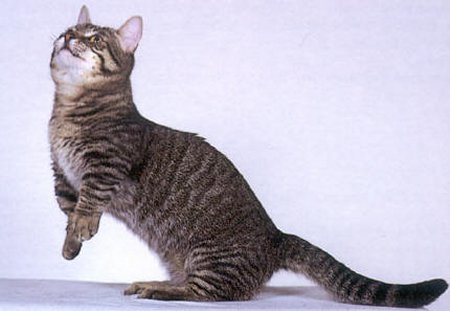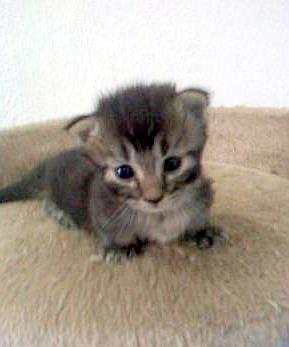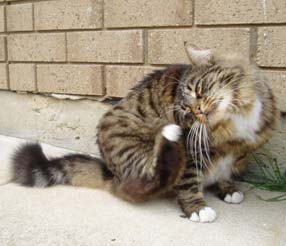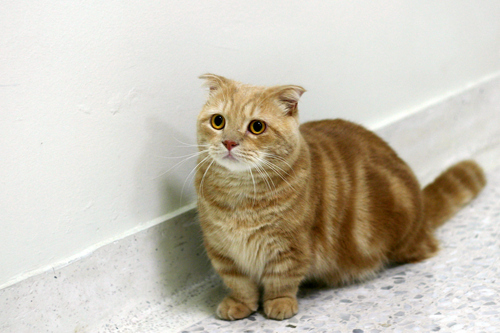



|
Munchkin Description
The Munchkin is a dwarf of a cat; long in body but short in stature. The head of the Munchkin is a modified wedge with rounded contours. It should be in proportion to the body with high cheekbones; jowls are permitted in males. Ears should be in proportion to the head, tilted forward to give an alert appearance and set equally on the top and sides. Lynx tips are acceptable only in longhaired versions. The eyes of the Munchkin should be medium to large, walnut shaped and open, giving an alert appearance. There is no coat- eye color requirement.
The body of the Munchkin is thick and semi-foreign; the spine should rise upwards from the shoulders, chest should be well-rounded, and hips firm. The distinguishing mark of the breed is the length of their legs. The legs of the Munchkin should be short and set evenly apart; upper and lower forelegs should be the same length. The rear legs may be longer in height than the front legs, however the lower leg and thigh should be of equivalent length. Feet should be round and compact, in proportion to the body and should face forward. The look of the cat should be of feline dachshund or corgi.
Munchkin Temperament
The Munchkin is a fun loving breed of cat, their stature does not affect how they view themselves; quite the opposite, the Munchkin seems to sense no difference between itself and a longer-legged counterpart. The have been described as ferret-like in their play, 'zooming' around the house, low to the ground as they chase toys. Their penchant for rising up on their hindquarters to observe something is a quality that endears them to many. They are self-assured cats and very outgoing. Their love of shiny objects has given them the nickname 'magpie', they will steal shiny items and socket them away to play with later. Proficient hunters, the Munchkin loves to end a hard work day by snuggling up in their favorite lap.
Munchkin Care
The Munchkin, despite rumors to the contrary, is a healthy cat that experiences no health problems due to it's shortened legs. The spine of the cat is easily able to handle the difference in leg length. Munchkins have pseudoachondroplasia and avoid the issues normally associated with dwarfism. Lordosis, or spinal dip, and Pectus Excavatum, flat rib cage, though seen are not unique to the breed and are found in many others. A visit to your animal health professional will identify these issues if they are present.
Grooming is simple. Munchkins require weekly brushing to keep the coat shiny and prevent matting in longhaired versions.
Munchkin History
Though a relatively new breed to the cat fancy scene, the Munchkin is surrounded in controversy and miseducation. It is important to begin the history of the Munchkin by noting that short-legged cats have been documented as far back as 1930's England and survived until World War II, which decimated much of the European feline population. One short-legged cat displaying the characteristic habit of sitting on its haunches was named the 'Stalingrad Kangaroo' in the 1950's Soviet Union. This breed is caused by a spontaneous genetic mutation which causes the legs to shorten, and is not the result of man-made breeding.
The Munchkin as we know it today has come up out of the South. In 1983, a schoolteacher named Sandra Hochendel discovered two cats pinned by a dog beneath a truck. Rescuing them, she noted that both were pregnant and displayed noticeably short legs. She gave the grey cat, Blueberry, away and kept the black one named Blackberry. Once Blackberry delivered her kittens, Ms. Hochendel gave a short-legged, male kitten named Toulouse to a friend who allowed her cats to run free and un-altered. This created a feral population of Munchkin cats in Monroe, Lousiana. They competed quite well with their long-legged counterparts for food and mating opportunities.
Genetic research of the Munchkin has determined that the short legs are the results of a dominant genetic mutation affecting the bones of the legs. It occurs spontaneously in the feline gene pool and any cat with the gene will display the short legs. The Munchkin gene pool, however is rather small and so breeders have outcrossed to any and all non-pedigreed domestics. This has led to a wide number of coat colors, patterns, and lengths, including a Siamese look.
In 1995, the breed received TICA recognition and one judge resigned in protest, calling the breed an affront to any breeder with ethics as there was at the time a strong belief that the shortened legs would cause spine issues. This has, however, not proven true. The shortened legs have caused no additional health issues and Munchkins live long, healthy and happy lives. Responsible breeders will not breed Munchkin to Munchkin and it is important that potential buyers ask for the pedigree of any Munchkin prior to purchase to ensure that only one parent is, in fact, a carrier of the gene.
|